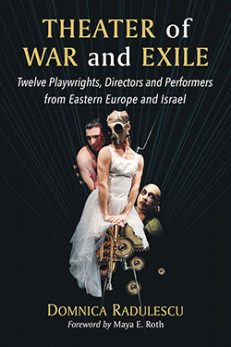Theater of War and Exile
Twelve Playwrights, Directors and Performers from Eastern Europe and Israel
$39.95
In stock
About the Book
In what ways does political trauma influence the art arising from it? Is there an aesthetic of war and exile in theatrical works that emerge from such experiences? Are there cultural markers defining such works from areas like Eastern Europe and Israel? This book considers these questions in an examination of plays, performances and theater artists that speak from a place of political violence and displacement.
The author’s critical inquiry covers a variety of theatrical experimentations, including Brechtian distancing, black humor, pastiche, surreal and hyper-real imagery, reversed chronologies and disrupted narratives. Drawing on postmodern theories and performance studies as well as interviews and personal statements from the artists discussed, this study explores the transformative power of the theater arts and their function as catalysts for social change, healing and remembrance.
About the Author(s)
Bibliographic Details
Domnica Radulescu
Format: softcover (6 x 9)
Pages: 264
Bibliographic Info: 25 photos (12 in color), notes, bibliography, index
Copyright Date: 2015
pISBN: 978-0-7864-7312-0
eISBN: 978-1-4766-1919-4
Imprint: McFarland
Table of Contents
Table of Contents
Acknowledgments vii
Foreword by Maya E. Roth 1
Preface 7
Introduction: Defining an Aesthetic of War and Exile 11
One. Exile as Ontological Mutation: Theater and Performance about Post-Communist Regions 37
Aglaja Veteranyi: The Tragi-Comedy of Nomadism 38
Saviana Stanescu: Balkan Roots, Western Wings 44
Pavel Zuštiak: All Movement, No Words 59
Exile Is My Home: Personal Testimonies on Creativity and Exile 66
Radmila Adamová: Eastern Europe Meets Indochina 77
Dorota Maslowska: Nomadism on Drugs 83
Two. Theater of War and Genocide, and Theater Dystopias 94
Matei Vişniec: Consciousness Raising Through Theater 96
Biljana Srbljanović: Postwar Dystopias 123
Milena Markovic: Grand Guignol Horror and Dystopia 140
Motti Lerner: Playwriting as Resistance to War 151
Between pages 162 and 163 are 8 color plates containing 12 photographs
Three. Performance as Memory Keeper and Promoter of Peace 163
Noa Baum: Storytelling as a Way of Understanding the “Other” 164
Marcy Arlin and the Immigrants Theater Project: Celebrating Diversity 173
DAH Theater Group: Performance as Promoter of Peace and Repository of Memory 184
Conclusion: Theater as Survival 200
Chapter Notes 223
Bibliography 233
Index 241
Book Reviews & Awards
“Recommended”—Choice; “Radulescu’s examination of the theater of the Balkans, Romania, Israel, and other sites of violence and exile demonstrates the power of theater to enable the survivors of trauma to document and witness, to reclaim the real, to produce social change, and to promote the possibility of healing, both on the personal and national levels…a model for understanding how artists depict and resist unspeakable violence and living a national identity far from that nation…will surely be of interest to scholars from a wide variety of fields.”—Kevin J. Wetmore, Department of Theatre Arts, Loyola Marymount University; “With an exile’s insight and an advocate’s clarity, with a scholar’s thoroughness and an artist’s passionate partiality, Radulescu assembles and frames an illuminating array of recent-and-contemporary theatrical manifestations that explore war-born, genocide-inscribed trauma.”—Erik Ehn, Professor and Chair of Theater Arts and Performance Studies at Brown University.





